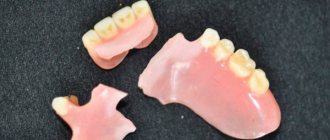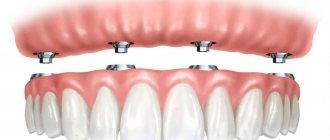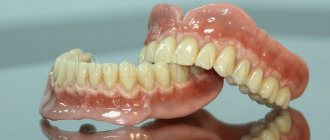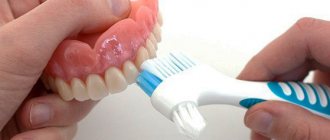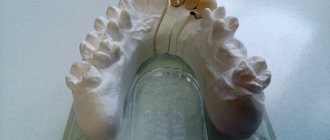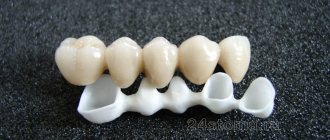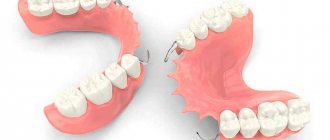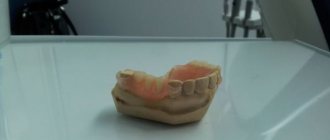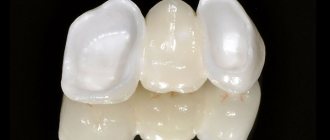The number of patients in dental clinics in need of prosthetics is growing year after year. Due to demand, the production of dentures helps dental clinics and offices prioritize this most promising area.
There are two types of dentures:
- Removable dentures.
- Fixed dentures.
The choice of material for the denture itself will depend on which of them will be used for prosthetics.
Materials for the manufacture of fixed dentures
The following materials are used in the manufacture of prostheses:
- ceramics;
- metal ceramics;
- composite;
- plastic;
- metal;
- dioxide (zirconium oxide).
It’s worth talking about each of them in a little more detail.
Ceramics
The material is as close as possible to the color and shade of natural teeth. But ceramic crowns themselves are not particularly durable, unlike glass-ceramics.
Metal ceramics
The basis of the frame is an alloy of precious or semi-precious metals coated with dental ceramics. The material is strong, durable, wear-resistant, aesthetic, but very expensive. Metal-ceramic crowns are one of the most popular types of dentures.
Composite
The main components of this material are polymer compounds of glass, quartz, silicon oxide and porcelain flour. The main advantage of the composite is its long service life (at least 15 years), but the main disadvantage is that it is very expensive.
Plastic
Used to make temporary crowns. Cheap in price and short-lived in use (up to 3 years) material.
Metal
It is used to make the basic elements of crowns. Most suitable alloys to use:
- Gold-containing.
- Nickel-chromium.
- Cobalt-chromium.
The choice of these alloys is due to the absence of oxidation and deformation during operation of the finished product.
Dioxide (zirconium oxide)
They are used more often for prosthetics of the chewing (distant molar) part of the oral cavity. Zirconium crowns are durable and almost indistinguishable from natural ones.
Indications
A removable denture is a design that restores the chewing and aesthetic functions of the dentition in the absence of conditions for fixed prosthetics. The patient can put on and take off this product at any time without the help of specialists.
Such prosthetics are performed in the following cases:
- the absence of one or more units in a row;
- complete edentia;
- simultaneous extraction of two or more teeth;
- before installing a fixed prosthesis as a temporary device;
- dental defects;
- looseness of the remaining units;
- severe form of periodontal disease;
- if you are allergic to the material of a fixed product;
- refusal of the patient himself (this may be caused by his fear of the implantation procedure, financial difficulties, etc.).
Prosthetics using removable structures includes a number of techniques. So, with complete edentia, specialists install a complete denture - this is the basis on which artificial chewing organs are placed.
It is supported by the palate of the upper jaw and the alveolar processes of both jaws. Stabilization of the product is ensured by the so-called “suction effect”, when a discharged area is formed between the mucous membrane and the prosthesis itself.
Typically, plastic or nylon is used to make its base, and porcelain or plastic is used for artificial units.
If one or more adjacent teeth are lost, a partial denture is placed. It consists of a base made of acrylic or nylon, simulating gum, and artificial teeth.
Its fastening occurs using clasps - metal support-retaining elements . They wrap around the natural unit, thereby stabilizing the position of the denture in the mouth. Partial structures come in two types - clasp or plate.
In situations where, for certain anatomical or medical reasons, the placement of bridge systems and removable products is impossible , a conditionally removable type of prosthesis is installed . This device can only be removed in a dental office.
Important! For many patients who want to restore the integrity of their dentition, prosthetics with removable types of structures is the only acceptable method of orthopedic treatment.
It successfully combines three important indicators - quality, effectiveness, cost.
Materials for the manufacture of removable dentures
The following materials are used to make removable dentures:
- nylon;
- acrylic.
Each of them has its own advantages and disadvantages.
Nylon
This is a modified plastic that prevents the occurrence of an allergic reaction and injury to the oral cavity, but has the ability to sag and change color when in contact with food. Nylon dentures are more comfortable.
Acrylic
The material is soft and flexible, but at the same time has good elasticity. Acrylic dentures are easy to clean with a toothbrush, but with prolonged use they can cause allergy symptoms in the mouth.
Possible breakdowns and repairs
Almost half of all orthopedic systems become unusable before the time specified in the guarantee, and in 10% of all cases this is observed in the first year of wear.
Common types of breakdowns are:
- cracks in the base of the structure;
- fracture;
- breakdown of clasps;
- chips on artificial units;
- violation of closure.
The reasons leading to such defects can be very different:
- Laboratory and technical errors.
- Careless attitude to the design.
- Violation of the rules of operation and storage.
- "Aging" of the material.
- Changes in the condition of tissues in the mouth (progressive atrophy).
If a prosthesis is found to be broken, you should contact the laboratory and the dentist. Repairing it without a doctor’s recommendation and lack of subsequent adjustments will certainly lead to another breakdown.
The following types of restoration work are carried out in the laboratory:
- an acrylic device can be glued together with a self-hardening resin, overlaying a new layer of polymerized plastic or with a special glue;
- if an artificial tooth is broken, it can be built up or a new one can be implanted in its place;
- if there is a problem with the clasp, the artificial unit and gums are first removed from the arch, and then the matrix and clasps are laser-soldered;
- the broken parts of the nylon device are connected with a fastening mass.
Trying to repair the structure yourself is not recommended. Experts do not advise doing this for the following reasons:
- The adhesive at hand can cause allergies or severe poisoning.
- The duration of operation of a self-repaired prosthesis is a week.
- Under an unsealed seam, food debris will accumulate and pathogenic microorganisms will multiply.
- It is impossible to properly restore the integrity of the structure at home.
Important! To extend the service life of the device and prevent its breakdown, it is necessary to correct it every six months and remove small, barely noticeable scratches by polishing.
Materials for the manufacture of fixed dentures
At this stage, you cannot do without a visit to the dental office, where the orthodontist performs a set of activities:
- A thorough examination of the oral cavity and identification of existing problems;
- Patient visiting the X-ray room. The image will help the specialist determine the condition of the bone tissue and possibly identify gum abnormalities;
- Sanitation of the oral cavity – removal and treatment of remaining teeth, removal of tartar, whitening (at the request of the patient);
- Selection of the shade of the artificial crown, the option of the future prosthesis and material;
- Taking a plaster cast of the jaw, on the basis of which diagnostic and auxiliary prostheses are made;
- Assessment of jaw occlusion and identification of possible deviations using wax rollers;
- Drawing a drawing of the future prosthesis on a diagnostic model;
- Drawing the outline of the frame on the working model, based on the marks of the diagnostic model;
- Contour correction using a parallelometer;
- Trying on the prosthesis and eliminating possible defects;
- Final fitting of the finished product, explanation of the rules of operation and care.
Evaluation of results
The evaluation of the results of prosthetics is carried out according to two main criteria:
- Subjective.
- Objective.
The first group includes indicators for analyzing the patient’s condition after placement of the prosthesis. Namely:
- how comfortable he perceives the presence of the structure in his mouth;
- How was the adaptation period?
- what difficulties does he face?
- Are you happy with the result?
The condition is studied at different periods - after fitting the prosthesis, after its application and a month after final fixation.
The second group of criteria includes the following areas of verification:
- correspondence of the crown shape to the anatomical parameters of natural units;
- occlusal and articulatory correspondence of both jaws;
- color match of artificial units with the shade of natural teeth (if any);
- correctness and tightness of the marginal fit of the structure to hard dental tissues;
- degree of restoration of jaw functionality;
- quality of polishing of the prosthesis.
Many experts supplement this list with another indicator, which indicates the number of complaints received from an orthopedic dentist over a certain period of time and the degree of defectiveness of the prosthesis.
Technicians' work
This manufacturing stage largely replicates the steps of the clinical process, since they are closely interrelated.
How dentures are made by technicians:
- Making a cast from plaster.
- Making an individual impression tray based on a plaster cast.
- Production of diagnostic and working models.
- Creating a duplicate of the working model.
- Plastering of the working and auxiliary models in the articulation.
- Placement of crowns on a wax base and filling with plastic.
- Replacing the wax with a polymer base.
- Assembly, polishing and grinding of the finished product.
- Sending the finished product to the orthodontist.
Manufacturing technology of fixed dentures
The technology behind creating fixed and removable implants is very similar. The only difference is in what dentures are made of, that is, in the material.
There are several types of permanent implants:
- Veneers.
- Crowns.
- Pin teeth.
- Bridges.
Since fixed dentures are worn for a very long time, taking impressions and making dentures must be approached more carefully and carefully.
Sooner or later, all people face the problem of prosthetics. The choice of a specific type of implant depends only on the patient himself, but in any case it is impossible without consulting a specialist. You shouldn’t put off visiting the dentist, and this, in turn, will allow you to subsequently surprise others with a beautiful “Hollywood” smile.
Clasps
Clasp denture with clasps
In case of partial absence of teeth, one of the ways to fix the prosthesis in the oral cavity is the presence of clasps. They are usually made of metal. They tightly cover the tooth, can only serve as a retaining element, and also act as a support, that is, transmit chewing pressure to the tooth. Noticeable when talking and smiling.
Clasps made of elastic material (nylon dentures) can only perform a retaining function. Excellent aesthetics, but unreliable and can become deformed and break.
